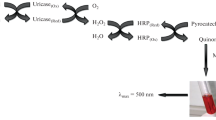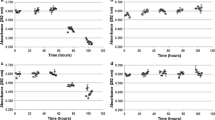Abstract
The most common methods for determination of uric acid in serum are based on the use of the enzyme uricase. Uric acid is enzymatically oxidized by oxygen to produce hydrogen peroxide, allantoin, and carbon dioxide. The four most often applied uricase methods are critically compared in this review.


Similar content being viewed by others
References
Zhao YS, Liao F (2007) Serum uric acid and hyperuricemia-associated disease. Int J Intern Med 34:41
Becker MA, Jolly M (2006) Hyperuricemia and associated diseases. Rheum Dis Clin North Am 32:275
Folin O, Macallum AB (1912) A new method for the (colorimetric) determination of uric acid in urine. J Biol Chem 13:363
Blauch MB, Koch FC (1939) A new method for the determination of uric acid in blood, with uricase. J Biol Chem 130:443
Sakuma R, Nishina T, Kitamura M (1987) Deproteinizing methods evaluated for determination of uric acid in serum by reversed-phase liquid chromatography with ultraviolet detection. Clin Chem 33:1427
Ingebretsen OC, Borgen J, Farstad M (1982) Uric acid determinations: reversed-phase liquid chromatography with ultraviolet detection compared with kinetic and equilibrium adaptations of the uricase method. Clin Chem 28:496
Lim CK, Pryde DE, Lawson AM (1978) Specific method for determining uric acid in serum using high-performance liquid chromatography and gas chromatography–mass spectrometry. J Chromatogr 149:711
Sanders GT, Pasman AJ, Hoek FJ (1980) Determination of uric acid with uricase and peroxidase [J]. Clin Chim Acta 101:299
Moss DW (1980) Methodological principles in the enzymatic determination of substrates illustrated by the measurement of uric acid. Clin Chim Acta 105:351
Pardue HL (1977) A comprehensive classification of kinetic methods of analysis used in clinical chemistry. Clin Chem 23:2189
Hande KR, Perini F, Putterman G, Elin R (1979) Hyperxanthinemia interferes with serum uric acid determinations by the uricase method. Clin Chem 25:1492
Tiffany TO, Jansen JM, Burtis CA, Overton JB, Scott CD (1972) Enzymatic kinetic rate and end-point analyses of substrate, by use of a GeMSAEC fast analyzer. Clin Chem 18:829
Duncan PH, Gochman N, Cooper T, Smith E, Bayse D (1982) A candidate reference method for uric cid in serum. I. Optimization and evaluation. Clin Chem 28:284
Duncan P, Gochman N, Bayse D, Burnett R, Carey N, Carter R, Fellows WD, Garber C, Kessler G, McComb R, Miller W, Nast P, Ryan W, Schaffer R, Tejeda B, Vanderlinde R, Widdowson G (1982) A candidate reference method for uric acid in serum. II. Interlaboratory testing. Clin Chem 28:291
Pesce MA, Bodourian SH, Nicholson JF (1974) Automated enzymatic micromethod for determination of uric acid in serum and urine with a centrifugal analyzer. Clin Chem 20:1231
Elin RJ, Johnson E, Chesler R (1982) Four methods for determining uric acid compared with a candidate reference method. Clin Chem 28:2098
Hoshi T, Saiki H, Anzai JI (2003) Amperometric uric acid sensors based on polyelectrolyte multilayer films. Talanta 61:363
Castillo-Ortega MM, Rodriguez DE, Encinas JC, Plascencia M, Mendez-Velarde FA, Olayo R (2002) Conductometric uric acid and urea biosensor prepared from electroconductive polyaniline-poly(n-butyl methacrylate) composites. Sensors and Actuators B 85:19
White RM, Cross RE, Savory J (1977) Enzyme-coupled measurement of uric acid in serum with a centrifugal analyzer. Clin Chem 23:1538
Kayamori Y, Katayama Y (1994) A sensitive determination of uric acid in serum using uricase/catalase/formaldehyde dehydrogenase coupled with formate dehydrogenase. Clin Biochem 27:93
Kayamori Y, Katayama Y, Matsuyama T, Urata T (1997) Enzymatic method for assaying uric acid in serum with a new tetrazolium salt produces water-soluble formazan dye. Clin Biochem 30:595
Trivedi RC, Rebar L, Desai K, Stong LJ (1978) New ultraviolet (340 nm) method for assay of uric acid in serum or plasma. Clin Chem 24:562
Fossati P, Prencipe L, Berti G (1980) Use of 3,5-dichloro-2-hydroxybenzenesulfonic acid/4-aminophenazone chromogenic system in direct enzymic assay of uric acid in serum and urine. Clin Chem 26:227
Lamb EJ, Price CP (1995) Use of azure-D2 for the measurement of uric acid in serum. Eur J Clin Chem Clin Biochem 33:595
Suzuki M, Takayanagi M, Yashiro T (1991) Use of the o-phenylenediamine fluorescence system in the enzymatic assay of serum uric acid. Chem Pharm Bull 39:2745
Majkic-Singh N, Said BA, Spasic S, Berkes I (1984) Evaluation of the enzymatic assay of serum uric acid with 2,2′-azino-di(3-ethylbenzthiazoline-6-sulphonate) (ABTS) as chromogen. Ann Clin Biochem 21:504
Trivedi RC, Rebar L, Berta E, Stong L (1978) New enzymatic method for serum uric acid at 500 nm. Clin Chem 24:1908
Dubois H, Delvoux B, Ehrhardt V, Greiling H (1989) An enzymic assay for uric acid in serum and urine compared with HPLC. J Clin Chem Clin Biochem 27:151
Kroll MH, Elin RJ (1994) Interference with clinical laboratory analyses. Clin Chem 40:1996
Aoki Y, Ihara H, Nakamura H, Aoki T, Yoshida M (1992) Effects of serum bilirubin on determination of uric acid by the uricase–peroxidase coupled reaction. Clin Chem 38:1350
Witte DL, Brown LF, Feld RD (1978) Effects of bilirubin on detection of hydrogen peroxide by use of peroxidase. Clin Chem 24:1778
Bhargava AK, Lal H, Pundira CS (1999) Discrete analysis of serum uric acid with immobilized uricase and peroxidase. J Biochem Biophys Methods 39:125
Martinez-Perez D, Ferrer ML, Mateo CR (2003) A reagent less fluorescent sol–gel biosensor for uric acid detection in biological fluids. Anal Biochem 322:238
Dobayb R, Harsanyib G, Visya C (1999) Detection of uric acid with a new type of conducting polymer-based enzymatic sensor by bipotentiostatic technique. Anal Chim Acta 385:187
Matos RC, Augelli MA, Lago CL, Angnes L (2000) Flow injection analysis-amperometric determination of ascorbic and uric acids in urine using arrays of gold microelectrodes modified by electrodeposition of palladium. Anal Chim Acta 404:151
Bartl K, Brandhuber M, Ziegenhorn J (1979) Improved automated kinetic determination of uric acid in serum by use of uricase/catalase/aldehyde dehydrogenase. Clin Chem 25:619
Lum G, Gambino SR (1973) Comparison of four methods for measuring uric acid: copper-chelate, phosphotungstate, manual uricase, and automated kinetic uricase. Clin Chem 19:1184
Goren MP, Davis JE (1986) Extending the linear range for kinetic reactions by considering the relationship between enzyme activity of the reagent and measurement intervals. Clin Chem 32:2021
Hamilton SD, Pardue HL (1982) Kinetic method having a linear range for substrate concentrations that exceed Michaelis–Menten constants. Clin Chem 28:2359
Dilena BA, Peake MJ, Pardue HL, Skoug JW (1986) Direct ultraviolet method for enzymatic determination of uric acid, with equilibrium and kinetic data-processing options. Clin Chem 32:486
Harris RC, Hultman E (1983) Kinetic methods that are independent of the rate of reaction. Clin Chem 29:2079
Liao F, Liu WL, Zhou QX, Zeng ZC, Zuo YP (2001) Assay of serum arylesterase activity by fitting to the reaction curve with an integrated rate equation. Clin Chim Acta 314:67
Liao F, Tian KC, Yang X, Zhou QX, Zeng ZC, Zuo YP (2003) Kinetic substrate quantification by fitting the enzyme reaction curve to the integrated Michaelis–Menten equation. Anal Bioanal Chem 375:756
Liao F, Zhu XY, Wang YM, Zeng ZC, Zuo YP (2004) Assay of uricase activity by integrated method at substrate concentration higher than Michaelis–Menten constant. J Fourth Mil Med Univ 25:1551
Liao F, Zhu XY, Wang YM, Zuo YP (2005) The comparison of the estimation of enzyme kinetic parameters by fitting reaction curve to the integrated Michaelis–Menten rate equations of different predictor variables. J Biochem Biophys Methods 62:13
Zhao LN, Tao J, Zhao YS, Liao F (2006) Quantification of reduced glutathione by analyzing glutathione-S-transferase reaction process taking into account of product inhibition. J Xi‘an Jiaotong Univer Med Sci 27:300
Liao F, Zhao LN, Zhao YS, Tao J, Zuo YP (2007) Integrated rate equation considering product inhibition and its application to kinetic assay of serum ethanol. Anal Sci 23:439
Liao F (2005) The method for quantitative enzymatic analysis of uric acid in body fluids by predicting the background absorbance. China: ZL 03135649.4
Liao F, Zhao YS, Zhao LN, Tao J, Zhu XY, Wang YM, Zuo YP (2005) Kinetic method for enzymatic analysis by predicting background using uricase as model. J Med Coll PLA 20:338
Liao F, Zhao YS, Zhao LN, Tao J, Zhu XY, Liu L (2006) The evaluation of a kinetic uricase method for serum uric acid assay by predicting background absorbance of uricase reaction solution with an integrated method. J Zhejiang Univ Sci B 7:497
Zhao YS, Zhao LN, Yang GQ, Tao J, Bu YQ, Liao F (2006) Characterization of an uricase from Bacillus fastidious A.T.C.C. 26904 and its application to serum uric acid assay by a patented kinetic uricase method. Biotechnol Appl Biochem 45:75
Zhao YS, Zhao LN, Yang GQ, Tao J, Bu YQ, Liao F (2007) Characterization of an extracellular uricase from Bacillus fastidious and its application in direct kinetic assay of serum uric acid. J Huazhong Univ Sci Technol Med Sci 36:239
Siekmann L (1985) Determination of uric acid in human serum by isotope dilution-mass spectrometry. Definitive methods in clinical chemistry, III. J Clin Chem Clin Biochem 23:129
Wilson ID, Plumb R, Granger J, Major H, Williams R, Lenz EM (2005) HPLC-MS-based methods for the study of metabonomics. J Chromatogr B Analyt Technol Biomed Life Sci 817:67
Acknowledgement
This work was supported by the National Natural Science Foundation of China (No. 30672009, 30700775).
Author information
Authors and Affiliations
Corresponding author
Rights and permissions
About this article
Cite this article
Zhao, Y., Yang, X., Lu, W. et al. Uricase based methods for determination of uric acid in serum. Microchim Acta 164, 1–6 (2009). https://doi.org/10.1007/s00604-008-0044-z
Received:
Accepted:
Published:
Issue Date:
DOI: https://doi.org/10.1007/s00604-008-0044-z




